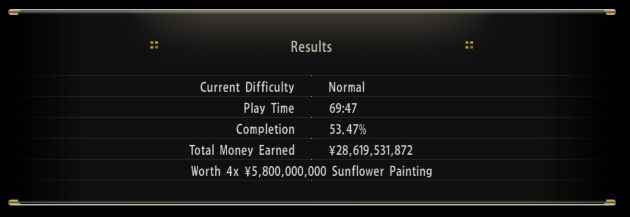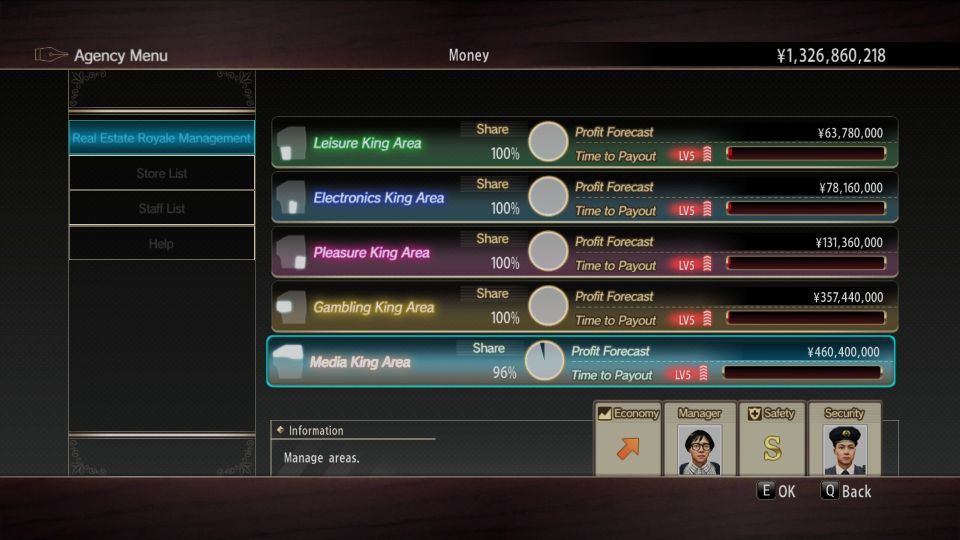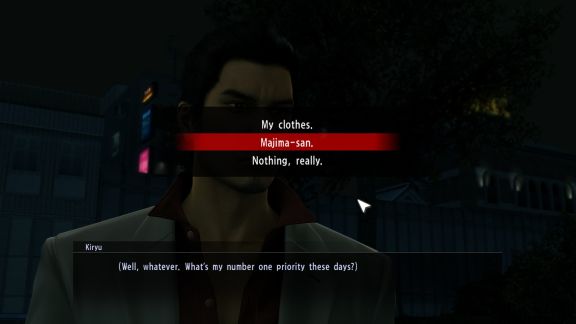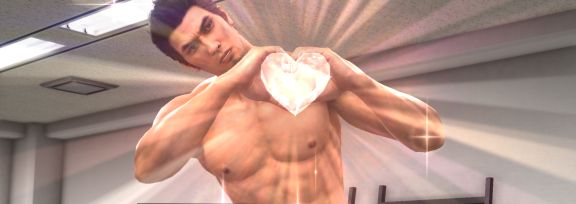Yakuza 0, Yakuza Kiwami, Yakuza Kiwami 2 - Gokudou Monogatari
The Yakuza series has always been the modern day version of Dragon Quest, right from the very first game. With the seventh game coming out in English recently, we're now seeing the series take the plunge into the full-on RPG experience with its new set of heroes, without for a second taking away from what makes it Yakuza. It looks great and I can't wait to dive in, but I must, because I picked a fight with every other game released on PC all in a row and the only way out is through a path paved with the blood of honorable gangsters.
A Story About My Uncle Kaz
My last Yakuza game before this latest binge was the first game for the Playstation 2. Not kidding. I had much the same reaction as I do now, proclaiming the series a modern-day action-RPG in the vein of the old greats. Much like the old greats, there were issues in translation, and the dub wrote everything a little grittier and curse-laden to make it sound more like a western crime piece, and that went so well that no Yakuza game had recieved a dub until Like A Dragon.
Speaking of Like A Dragon, we all know that that's what the entire series is called in Japan by now, right? Ryu ga Gotoku, same name as the game studio. Though every single game has dealt with the yakuza extensively, the protagonist Kiryu has been a civilian for most of the game's timeline. He's just a kind an honorable civilian who is built like a tank and cares enough about the Tojo Clan to constantly butt in to assist during their yearly near-destruction by outside forces. The name Like A Dragon refers to the way Kiryu rises to fight these obstacles head on, a trait that new protagonist Ichiban inherits.
Side note on the name talk: due to the unforseen circumstances of a game coming out in the Yakuza series that isn't about the yakuza at all, the Yakuza-style Fist of the North Star action-RPG Lost Paradise was stymied a bit in the west due to having no front-of-box tie-in to the Yakuza series; the Japanese name Hokuto ga Gotoku translates to Like the North Star, and the main characters in the Japanese dub are played mostly by characters from the Yakuza series. Not just the voice actors: the voice actors playing the Yakuza characters playing the Fist of the North Star characters. The first time I realized this, while watching a video of Kiryu-voiced Kenshiro battling a Ryuji Goda-voiced Raoh, I thought it was the coolest thing ever.
Sadly I don't own a PS4, so I will never know the joys of Kenshiro's subtly explosive face massage. Nor will I experience Kiryu's final turn as protagonist in Yakuza 6: The Song of Life, a game that knew its series was going full RPG and chose its title accordingly. I'm also blowing off the trio of games from Yakuza 3 to Yakuza 5, also known as the "Kiryu and Friends Trilogy", for the same reason. Being a PC gamer for the last couple console generations has had its downsides. And of course Dead Souls is a hard pass because of my extreme fear of zombie-based cash-ins on popular series, so I'm just going to focus on the PC trilogy that I have in front of me.
The trilogy of games on the PC is called the "Premake Trilogy", by the way.
Yakuza 0, or: The Pre

Yakuza 0 is known as "The Pre" because it is the prequel part of the "Premake Trilogy". The adventures of a younger Kiryu and Majima in the economic bubble of the eighties lays down a new beginning full of story hooks to extend into the Kiwami remakes, effectively allowing the writers to pre all over the original scripts to those games in an effort to tie up loose ends and plot holes.
Every last fiber of Zero is tied into the feeling of the era, from the retro redesigns of Kamurocho and Sotenbori to the main plot being driven by an insignificant plot of land worth billions to the side-stories all the way to the fact that Majima is a master of breakdancing. You're never not cooing over how unbelievably eighties everything is, the air above the streets burning hot with endless neon, thugs spilling wads of dough with every punch like River City Ransom. That's from 1989, so period-appropriate!
The cash flying around very quickly becomes both incredibly important in progressing level-wise and completely laughable to spend on anything in the game world. Points in skill trees cost ever-increasing amounts so it's important to 'invest in yourself', as an old man named Bachus reminds Kiryu early on, and as you go from the inner circle of the skill trees outward you'll find yourself needing exponentially more money to increase your fighting power.
Your only choice at this point is to become a filthy capitalist and invest heavily in citywide monopolies.
Essence of Capitalism
I have two major thoughts in my head. First, capitalism the way that capitalists want it, with arrows pointing straight upwards towards infinite profits, can only exist in the world of videogames because it's a fairy tale. Second, Yakuza 0's implementation of capitalism kind of sucks!

Though I only completed the game just recently, my Yakuza 0 save file is over a year and a half old. The last time that I played I had been so engrossed in the story but I also tried to clear as much of the side content out as possible. Around the time that I'd gotten to the later chapters I found myself hamstrung by the business minigames, specifically Kiryu's. The Kamurocho Real Estate Royale is the single largest source of money in the game, as well as the biggest money and time sink in the game.

The real estate office is located just north of Tenkaichi Street, the classical series main street, and you will find yourself coming back here over and over and over again, tossing money at local thugs knowing full well that the payouts from your property will cover the cost thousands of times over compared to the cost of wasting time fighting. When you get into the building you'll collect your money one section of the city at a time as Kiryu says one of three or so lines about how well his investments are doing. You invest money in your properties using agents found throughout the game with varying levels and stats, then switch around the management and security of each area of town in a similar way. Then you start collecting and run off to do whatever else you feel like until the payout is ready, and the cycle continues.

My time after Real Estate Royale was a mess of sidequests punctuated by long runs across town to the Sugita Building #2 just north of Tenkaichi Street for hours and hours on end. As new rivals appeared in the minigame's story I'd spend countless time on the lookout for new properties to make more money off of. None of these properties are marked by icons and the only way to confirm is to stand in front of the building and hit the A button when the Look prompt appears in the corner of the screen. The only way to find these properties, then, is to either use the list of available businesses and a grasp of the written Japanese language to find each building, or run up against each and every building mashing the A button until you find them. My reading comprehension level is so low that I did a little of both.
By the time I reached the final rival in Real Estate Royale, I had gone through so much completionist nonsense that I literally forgot to finish the game until I could force myself to stop trying to 100% the game and just get back into enjoying the story.
Essence of Being the Better Shenmue
As Kiryu and Majima are in their more formative years they're both funneled into learning different fighting styles through "Revelation" cutscenes in the course of their stories, referencing the popular cutscenes from the third through fifth games. Though they're all good in different situations I've found Kiryu's Brawler and Beast styles way more useful than Rush, mostly because of how difficult it is to actually pull of the Heat action once an enemy is stunned. More often than not I'll end up jabbing thugs out of stun and getting socked before I can back off. On the other hand all of Majima's styles feel like they have utility, though Breaker can be a little unwieldly and difficult to time if you're not just Eddy Gordo button mashing.
Zero's Heat system is based around a three-gear gauge, with various upgrade abilities only being available in certain gears. Recharging Heat via blocking is a 1st to 2nd gear only ability, for example, and being able to stay standing after getting shot is a 3rd gear only thing. The problem is that you lose Heat so quickly when you take hits in this game that in more difficult fights it is impossible to hold on to enough Heat to push through to the end. At this point you can get better at combat and/or carry more items with you, but it doesn't make the combat feel any better.
The story of Zero, in the end, is the story of how youngboy Kiryu and butler Majima get their modern day costumes. The last thing they both do after resolving their conflicts is don their iconic gear in back to back scenes, as Kiryu goes on about not seeing in terms of black and white any more and Majima resolves to take life less seriously. Before the credits roll, a smattering of characters are giving a "Where are they now?" update on their lives leading up to the first Yakuza. Even this choice feels somewhat evocative of films of the era, though I might just be reading too far into some clumsy writing.
Between the capitalist grind and the credit roll, a whole host of other things happen. If you've played any of the series up until now and you don't recognize a character from a later game you can expect that character to die in this one or otherwise appear in the Kiwami games, and more on that later I promise. The power struggle between future dead guys is so twisted that at times, it's hard to keep track of who is on our boys' sides, but part of the excitement of the plot lies in how everything shakes out in the end. We know there'll be a massive tower in the place of the Empty Lot no matter what, but who stands to profit the most from it?
The relationship between young butler Majima and his asshole jailer Sagawa is one of my favorite parts of the plot of Zero. At the start of Majima's story we see that Sagawa goes through great lengths to make sure that Majima doesn't leave Sotenbori and has no problems twisting the knife a bit verbally. He's a snarky, dismissive jerk, but it's always just business to him. When he goes from uncertain enemy to ally after a few uncertain moves near the end it shows that the profit from the Empty Lot is worth more than Majima's eternal punishment to Shimano, and thus to Sagawa. In effect, this bit of pre does more to paint Shimano as a cruel dick, making his downfall in the future Yakuza game satisfying enough for Majima that in Kiwami he even sends you a text promising that he won't swear vengeance for his murdered patriarch.
Nishitani, meanwhile, is just Majima's Zack. After the game, Shimano had Majima put in a vat of Mako energy and he absorbed all of Nishitani's memories and personality in time for the first game. Moving on!
Futae no Kiwami

Yakuza Kiwami, or Yakuza X-Treme for all you early 2000s hip kids, is the first Yakuza remade in the engine of Yakuza Zero, with all of the joys and issues of such tweaked to fit the style of the original. This one doesn't lean so hard on mindless capitalism, so those of us who are troubled by financial anxieties can breathe easily and level up using experience points like a regular RPG-type. You still have the fighting styles from Zero, and they all begin considerably stronger than at the start of that adventure. Almost like they knew someone would be going from one game to the next and wouldn't want to wade through the shallow end again!
This game is the original ported and polished to the nice new game engine, with many of the minigames from Zero making a return to make up for the original's lack of them. Many side-quests from the original have been made into side missions including a chain of missions involving assassins sent by Dojima's widow so it's now easier to miss out on them, but there's so much going on that you might not notice anyway. Since you can hold more items and have a whole separate weapon inventory, as well as a handful of fighting styles, combat seems way easier than the original. As a bonus the Heat system is more like the original game than Zero, making it infinitely more useful.
According to Steam, I played through Yakuza 0 in about eighty hours, and Yakuza Kiwami in thirty. Without money to get in the way the experience is rather straightforward compared to the sprawling two-city adventure of Zero, and as advertised Majima is everywhere. You can fight Majima all day. He comes out of the sewer and he comes to play you in minigames. He's always looking for a fight and he's always chock full of experience points. But sometimes you'll fight him on patrol and he's unbelievably strong with a ton of health, but then you take him on in a different encounter and he's weaker. Perhaps the different Majima Everywhere encounters level up at different rates and my habit of bum-rushing him in the streets got the better of me?

The other issue is that Majima is the dread gatekeeper of Kiryu's ultimate style, making it nearly useless for the entirety of the game. The Legend style in Kiwami is available from the start, unlike Zero where it was stuck at the end of the Real Estate Royale minigame I didn't want to bother with after getting too burnt out on capitalism and thus useless to me. The problem with it in this game is that you can only gain certain skills for the Legend style by fighting different types of Majima, and due to my tendency to run straight towards Majima in the streets I would normally hit the Majima level cap pretty early on in each chapter of the story. So my Legend style, by the end of the game, was only slightly more powerful than Brawler, and mostly useful when low on health due to a skill that made it twice as fast in critical. They could've taken that style out of both games and Extreme Heat attacks out of this one and ended up with two way better games.
In a lot of ways it feels like the Kiwami bits are welded on like tacky fenders to the otherwise exciting story of Yakuza. The cutscenes were redone in the new engine with meticulous attention to detail, but any new details or leftover pre from Zero are dealt with in dialogue boxes. Extra cutscenes involving Nishikayama's fall to darkness were added famously but they don't tell us much that we don't already know about the guy. And the addition of Majima as Kiryu's constant sparring partner does nothing to stop him from kidnapping his new daughter Haruka with the purpose of challenging him to a fight the same as he does in the original, as if the various battles we had in the streets just weren't enough; and he still drives a truck straight into Shangri-La hellbent on one last battle, nevermind the fact that we just had a homerun battle down the road, and never mind the fact that I'm going to run into him a few blocks away after this match, dressed like a zombie.
The reward for maxing out your Majima Everywhere rank is one final battle with Majima. Unfortunately, I've already beaten the game so that will have to never happen. Sorry, my time is more important than that achievement!
Kiwami is Shaped Like a Friend

Currently, my play time for Kiwami 2 is close to forty hours. I'm nearing the end of the game but there's still enough things to mess around with before the inevitable final battle with Ryuji, so I've gone off on a trip with Haruka for the second half of the game's "Daddy-Daughter Day" sessions. During the story of the game, Kiryu will take some time off with Haruka in each of the game's cities before a major event, leading to the two walking around town doing things to build up Haruka's trust gauge. Most of the time she's asking Uncle Kaz for steak or sushi or an entire crab on a plate, but sometimes she'll ask you to do some really hard minigame challenge, like beating the fist three stages of Virtua On or clearing the 3x3 bingo board golf challenge, or actually understanding the rules of oicho-kabu. Sometimes she just wants you to pick up a military-grade piece of armor from Don Quixote so you don't get cold out when you're fighting thugs. She's a nice girl.
Compared to Majima Everywhere in the last game, these 'Haruka Everywhere' moments might seem lacking, but that has given me more of an excuse to do them, strangely enough. I stopped chasing Majima Everywhere because I was tired of the absolute fucking gall the first Kiwami had, making me grind through hordes of Majima just for the ultimate combat skills that I'd only need to fight Majima one last time. There were some cute cutscenes where he explained some of his past issues to Kiryu but none of that is really new to us, the player... I mean, nothing besides the fact that Majima looks decent in a dress.
Bonfire Lit
Where was I? Oh yeah, the compactness of the experience with Haruka actually made it a bit more worth dealing with. Majima's cool but the expansive ideals of Majima Everywhere were hamstrung by the janky reality of the experience. Perhaps the first game should have reeled Majima Everywhere back to a series of hand-holding dates between Kiryu and Majima and just left it at that.
Futae no Kiwami (oh wait used that one already)
The second Kiwami feels like a whole different beast than the first right out of the gate, thanks to that nice new Yakuza 6 engine. Kamurocho is the exact same city only bigger, more reflective, with automatic doors you can walk right through without loading and stairs you can run up to strange side hallways filled with stuff. You can walk first person across the game world and really get in there to study all the merchandise in Don Quixote, or the many odd business signs all over the city, if you're that kind of dork.
I'm that kind of dork.
The extra visual fidelity has made what feels like my fifth Groundhog Day loop through Kamurocho feel quite fresh, and though I feel some series fatigue setting in, this is offset by the brand new variety of experience compared to the last two games. Playing an arcade-perfect port of Virtual On is exciting, even if the AI is still crazy difficult. Recruiting an entire stable of NJPW pro wrestlers for Majima's construction company is a kick for a total mark like me, and the cabaret club minigame from Zero returns with some welcome improvements. Though, with the newest game downloading even as we speak, I wonder how much longer I'll be spending with the Kawami 2 collection of diversions.
Extreme Climax Heat
The Yakuza series has long been a series with varying levels of respect for your time, as a player. While filling out all the sidequests, completing all the minigames, eating every piece of food in every restaurant, maxing out your coliseum rank, learning every skill, opening every coin locker, and making your adoptive daughter love you with impossible amounts of Japanese cuisine might be a lot for a completion-minded gamer, the story itself can be pushed through in a more reasonable amount of time. For some people the Premium Adventure mode at the end of the game is more of a feature than the game itself, and each game is thoughtful enough to put a Premium Adventure new game mode in alongside various New Game Pluses.
Going in to Like a Dragon, I'm curious to see what about the basic Yakuza experience will change and to which extent. Despite the move to full-on RPG, the game still features the same engine and basic gameplay loops, the same ever-expanding sets of side activities, and the same Sega UFO Catcher machine, albeit with different prizes. Though the body may change but the soul remains the same, and that shit's exciting.